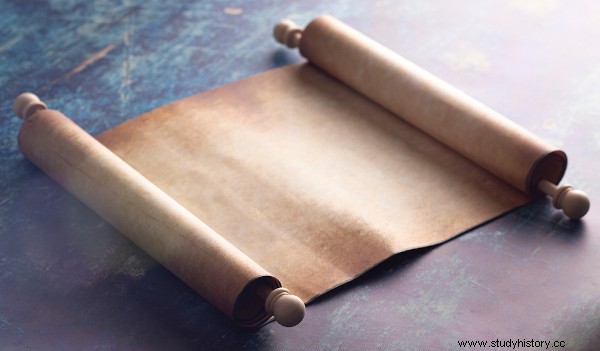
The scroll it is a surface that was used for writing, being very popular in part of the Ancient Age and the Middle Ages. It was produced from the skin of some animals (sheep and sheep, for example), and its production process was time-consuming and expensive. It was created in the 2nd century BC, in Pergamum, a Greek city located in Asia Minor. Parchment was considered a better quality writing medium than papyrus, as it was stronger and more durable.
Read also: Mayan writing — one of the most developed writing systems in Mesoamerica
Summary on parchment
-
Parchment was a very popular writing surface in the Ancient and Middle Ages.
-
It was made from animal skins and had a very long production process.
-
It was created in Pergamum, a Greek city in Asia Minor, in the 2nd century BC
-
Replaced papyrus as it was considered stronger and more durable.
-
Its high price made scribes reuse it as often as possible.
-
It lost ground with the popularization of paper and the invention of Gutenberg's printing press.
Parchment:what is it?
Parchment is a surface that was used for the writing of texts , partly from the Ancient and Middle Ages, becoming one of the most popular media. It was known to be tougher than other writing surfaces (such as papyrus) as it was made from animal skins.
However, it was considerably expensive due to its long production process, so its use took a few centuries to become popular. The material is believed to have been created in the city of Pergamum , located in Asia Minor (present-day Turkey), in the 2nd century BC
What was writing like in the Ancient Ages?
The fabrication of surfaces for graphic records was a necessity that arose with the development of writing. We know that the first form of writing recorded by mankind was cuneiform , developed by the Sumerians between 3500 BC. and 3000 BC. Different materials such as clay, wood, plaster and wax were used to record texts.
The first writing surface that became popular was papyrus, used by different civilizations. It was produced from a plant (Cyperus papyrus) that was found in abundance in the Nile Delta. Egyptians and Greeks referred to it as papyrus.
The material was produced using the plant's stems, which were cut into thin strips and placed overlapping each other to form a surface. The papyrus then went through a process of drying, polishing and receiving an oil as a varnish. The most accepted hypothesis is that this process was developed by the Egyptians.
This was one of the most popular writing surfaces from Ancient Age and was stored in rolls. In Egypt, its use was mainly for recording information of a religious or governmental nature. Egypt produced papyrus in large quantities and exported it to neighboring peoples, such as the Greeks. The material was widely used until the 11th century.
Learn more: Egyptian literature — recorded in inscriptions or written on papyrus
How was parchment produced and how was it used?
Parchment was the surface for writing that succeeded papyrus as the most used by European civilizations. It was created in Pergamum, a Greek city located in Asia Minor, in the 2nd century BC, and one hypothesis points out that this was due to a disagreement between Eumenes II and Ptolemy.
Eumenes II was the king of Pergamum and wanted to build a great library in his city. This would have bothered Ptolemy, King of Egypt, as he wanted only Alexandria (Egyptian city) to have a large library. With that, Ptolemy decided to stop the sales of Egyptian papyrus to Pergamum. This motivated the King of Pergamum to encourage the invention of an alternative to papyrus.
This invention would have been the parchment, the result of a long process that we will see later. Parchment was called by the Greeks pergaméne and its name derives from the city in which it arose:Pergamum. Your production was carried out with the skin of some animals , such as goats, sheep, cows and lambs.
It was a process that took weeks , and this long duration meant that the material was considered a very expensive commodity . First, the animals' skin was washed, the purpose of which was to remove impurities from the hide. Subsequently, the leather was allowed to drain and underwent a long drying process.
Finally, the hides were stretched on a rod, making them easier to fold, making the leather more malleable; the last remnants of hair were scraped from the strips, and finally they were polished. In the end, thick sheets were obtained, perfect for recording texts. Writing was done with inks and the use of the goose quill.
The good quality of the parchment made it much more durable than papyrus . In addition, it had a great advantage:the information contained in a parchment could be erased using objects, such as a knife. Some scrolls could be reused several times, and when that was the case, they were called palimpsests.
The reuse of scrolls it happened because it was a very expensive material, which forced scribes to resort to this alternative. This medium was very popular during part of the Middle Ages, and through it came the codex, the modern book, which was organized with leaves in sequence that were tied by a thread and protected by a hard cover, like a notebook.
Parchment was quite popular until the 14th and 15th centuries , but the emergence of paper in Europe and Gutenberg's invention of the printing press contributed to paper becoming the most used writing surface.
